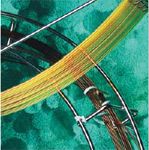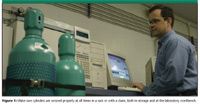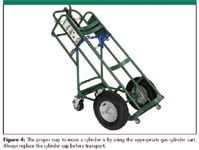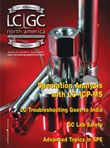Laboratory Gas Safety
LCGC North America
You have purchased a new gas chromatograph. Your company's safety office has completed a review of your lab's supplies. Before setting up your gas chromatograph, you read the instructions and familiarize yourself with the instrument. You might even give some thought to the exposure risks for the various substances in your samples. Yet, what about the less visible risks inherent in the gas delivery system that makes this a gas chromatograph?
Laboratory gases, as with most laboratory supplies, have risks that must be understood to use them effectively. This column will provide an overview of safety information, especially for the gases used in gas chromatography (GC).
First, require that all employees who might encounter the gas cylinders read and understand the Materials Safety Data Sheets (MSDS) for each gas and gas mixture. Also, make sure they are familiar with the labeling on the cylinders. Every cylinder delivered to your laboratory must bear clear labeling, according to the United States Department of Transportation — which regulates compressed cylinders. Cylinder color should never be used to identify contents. A shoulder label should indicate the product's shipping name and identification number. On pure products, a grade label also is applied. The shoulder label identifies the cylinder contents. Labeling also must have one or more of the hazardous materials diamonds as outlined by 49 CFR 173 and HM 126f.

The most common laboratory gases are:
- carrier gases — helium, nitrogen, and hydrogen;
- flame ionization detection (FID) gases — hydrogen, hydrogen mixtures, other fuel gases, and air;
- supercritical and coolant gases — liquid nitrogen and carbon dioxide;
- inductively coupled plasma (ICP) gases — argon, compressed and in liquid form;
- electron-capture detection and nuclear counter mixtures — methane–argon mixtures; and
- atomic absorption (AA) gases — nitrous oxide and acetylene.
Next, educate your employees so that they understand the five main hazards associated with laboratory gases.
Pressure-Related Dangers
The U.S. DOT considers all compressed gases hazardous, simply because they are under pressure. Most cylinders of laboratory gases, such as helium, hydrogen, and gaseous nitrogen, are delivered with 2000–2400 psig of pressure. Some gas cylinders are shipped with as much as 10,000 psig. A cylinder with a damaged valve can take off like an unguided missile. If the cylinder itself is damaged — by an electric arc, for instance — it can explode, sending shrapnel across the laboratory.

Figure 1
Even downstream from the cylinder, pressure dangers remain. Each valve, regulator, pipe, connection, and fitting must be rated to handle the applied pressure at that point in the gas delivery system. Valves provide flow control and regulators reduce gas pressures to safe working levels. The Compressed Gas Association (CGA) has specified standard outlet fittings for valves and regulators to avoid connections of the wrong gas. Bypassing or modifying the regulator, or a regulator failure, could cause a system rupture. Installers should construct systems with check valves and pressure-relief devices even if local codes do not require them, to reduce the chances of pressure-related problems.
When using liquefied gases, it is important not to trap any liquid between two valves. As gases vaporize, they expand many times, which could result in a pressure rupture. Also, when switching gas supplies from liquid to high-pressure cylinders, keep in mind that a system designed for a liquid dewar of argon at only 22 psig will not handle the much higher pressures of a gaseous supply adequately.

Figure 2
Asphyxiation
Simple asphyxiation is a primary hazard associated with most gases. Because inert gases are colorless and odorless, they can escape into the atmosphere undetected and quickly reduce the concentration of oxygen below life-sustaining levels. Yet, keep in mind that all gases, with the exception of compressed air and oxygen, pose this danger.
Liquefied gases pose an added asphyxiation risk because they produce large volumes of gas when they vaporize. If a sufficient amount of liquid is vaporized, particularly in a confined space, it will create an oxygen-poor environment quickly. For example, a small spill of liquid nitrogen expands to 696 times its liquid volume when it vaporizes. In a confined space, this would pose an immediate health hazard. Use and store liquid cryogens in well-ventilated areas and vent exhaust streams to safe locations.

Here are some other simple tips for proper storage and usage of cylinders
End-users should monitor oxygen levels in areas of cryogen use and in enclosed areas where gases are used and stored. Never enter an area where oxygen levels are below 19.5%. If the oxygen concentration in the room falls below 19.5%, personnel should deploy and don self-contained breathing apparatuses (SCBA). Transport of cryogenic containers in elevators should be avoided unless absolutely necessary. If an attendant must be in the elevator, the worker should have an escape pack with supplemental breathing apparatus and no other personnel should be in the car.
Fire and Explosion
Fire and explosion are the primary hazards associated with flammable gases, as well as oxygen and other oxidizing gases. Any heat source, such as a flame or a hot object, or even static electricity, can ignite flammable gases. Oxygen and other oxidizing gases do not burn but will support combustion of flammable materials. Increasing the concentration of an oxidizer accelerates the rate of combustion. Materials that are nonflammable under normal conditions can burn in an oxygen-enriched atmosphere.

Figure 3
The most common flammable gases in the laboratory are acetylene used in AA and hydrogen used as a carrier gas or as a detector gas in FID, flame photometric detection, and thermionic or nitrogen–phosphorus detection. And do not forget any propane on hand for flame photometry. Nitrous oxide in AA is an example of an oxidant.
Temperature Danger
Gases delivered in low-pressure cryogenic dewars pose a risk of cryogenic freezing. Make sure that all gas users know the temperatures of the various liquefied gases with which they will be working. In the laboratory, the most common examples are liquid argon, -186 °C (-302 °F); liquid nitrogen, -196 °C (-320 °F); and liquid helium, -269 °C (-452 °F). Carbon dioxide, though not a cryogenic gas, is also hazardous when the liquefied compressed gas evaporates, at about -78 °C (-109 °F). Unlike the other liquefied gases, which create relatively low tank pressures, liquid carbon dioxide creates a tank pressure of over 900 psig at room temperature and requires a regulator capable of handling the higher pressure.

Figure 4
Laboratories must take adequate precautions to protect workers who handle cryogens. Due to their extremely cold temperatures, cryogens will freeze human tissue rapidly. Therefore, insulated gloves approved for use in cryogenic service must be worn when operating valves, or when the potential exists for contact with the cryogen product or exposed cold piping. Gowns, safety glasses, and face shields also should be worn to prevent injury to the face and eyes. Transfer lines should be approved for use with cryogens and should have a phase separator to help prevent cryogen splashing.
Transportation and Storage Hazards
Handling cylinders requires special attention to safety. At as tall as 5 ft and 500 lb empty, a falling cylinder can injure employees or result in a broken valve. Therefore, make sure cylinders are secured properly at all times in a rack or with a chain, when they are in storage and at the laboratory workbench.
When moving a cylinder, close the main cylinder valve, remove any regulator, and replace the protective valve cap before moving and during storage. This will prevent the valve from being sheared off should the cylinder topple, turning a harmless looking cylinder into a projectile that can penetrate concrete walls. Never lift a cylinder by the valve cap, as the threads are not designed to handle the load. Never use slings or magnets to assist with a cylinder transfer. The proper way to move a cylinder is by using the appropriate gas cylinder cart.
Beyond educating personnel on these hazards, there are a number of other steps you should take toward full safety preparedness:
Have an emergency plan: Emergency plans are essential to safe laboratory operations. Review the plan and practice emergency drills regularly so both are up to date. Inform personnel of the potential hazards of the gases with which they are working and train them to carry out emergency plans and first aid procedures. Inform local hospitals, fire departments, and other local emergency response organizations of the gases in use so that they, too, will be prepared in the event of an emergency.
Enforce the "dress code:" Require personnel to wear suitable protective clothing, including gloves, eye protection, and face protection. Keep in mind that a face shield alone is not adequate protection for the eye and should always be used with protective eyewear. Safety equipment, such as self-contained breathing apparatus and fire extinguishers, should be located near hazardous areas.
Follow the rules: Follow all federal, state, and local regulations pertaining to the storage and use of compressed gas cylinders. CGA Pamphlet P-1 provides excellent guidance. Follow the National Fire Protection Association (NFPA) codes, especially for flammable products.
Tap the expertise of your supplier: Talk to your local gas suppliers to be sure that they are equipped to respond to any emergency involving the products they provide and for correct handling and storage procedures. They also should be able to explain what emergency-response services are available locally. Most gas companies have their own emergency response teams trained to respond to the specific risks of cylinder gases. Most supply companies also have technical support lines to answer nonemergency technical questions, which is especially helpful during the set up of a laboratory. Almost all the suppliers post safe-handling information online.
In conclusion, compressed and liquefied gases offer a safe and economical form of gas supply to laboratory applications. With proper use, these gases will help your new GC system improve your laboratory's productivity as well as the other important "P's" for your operations: proactive education of employees prepares them, and in turn, prevents accidents.
Chuck Hollenbeck is director of analytical markets for Airgas, Inc.
Derek F. Gill is technical director for Airgas' SAFECOR department and leads the Airgas Emergency Response Organization (AERO).
John V. Hinshaw "GC Connections" editor John V. Hinshaw is senior staff engineer at Serveron Corp., Hillsboro, Oregon, and a member of LCGC's editorial advisory board. Direct correspondence about this column to "GC Connections," LCGC, Woodbridge Corporate Plaza, 485 Route 1 South, Building F, First Floor, Iselin, NJ 08830, e-mail lcgcedit@lcgcmag.com For an ongoing discussion of GC issues with John Hinshaw and other chromatographers, visit the Chromatography Forum discussion group at http://www.chromforum.com

John V. Hinshaw

Detecting Hyper-Fast Chromatographic Peaks Using Ion Mobility Spectrometry
May 6th 2025Ion mobility spectrometers can detect trace compounds quickly, though they can face various issues with detecting certain peaks. University of Hannover scientists created a new system for resolving hyper-fast gas chromatography (GC) peaks.
Altering Capillary Gas Chromatography Systems Using Silicon Pneumatic Microvalves
May 5th 2025Many multi-column gas chromatography systems use two-position multi-port switching valves, which can suffer from delays in valve switching. Shimadzu researchers aimed to create a new sampling and switching module for these systems.
New Study Reviews Chromatography Methods for Flavonoid Analysis
April 21st 2025Flavonoids are widely used metabolites that carry out various functions in different industries, such as food and cosmetics. Detecting, separating, and quantifying them in fruit species can be a complicated process.

.png&w=3840&q=75)

.png&w=3840&q=75)



.png&w=3840&q=75)



.png&w=3840&q=75)












